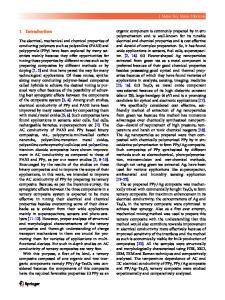Identification of zero-flux planes and flux reversals in several studies of ternary diffusion
- PDF / 740,068 Bytes
- 8 Pages / 603.28 x 788 pts Page_size
- 11 Downloads / 333 Views
I.
INTRODUCTION
CONCENTRATION profiles of isothermal diffusion couples in multicomponent systems can be analyzed directly for interdiffusion fluxes without invoking Fick's law. From such analysis of concentration profiles, the development of zero-flux planes (ZFP) and flux reversals for the individual components were first identified1 in the diffusion zones of diffusion couples in the Cu-Ni-Zn ternary system. At a ZFP, the interdiffusion flux of a component goes to zero and normally has opposite directions on either side. Depending on the terminal alloys of the couple, a component can develop more than one ZFP within the diffusion zone and more than one component can exhibit ZFP formation. The ZFP compositions for the Cu-Ni-Zn couples appeared to correspond I to composition points of intersection of diffusion paths and isoactivity lines of the individual components drawn through the terminal alloys on a ternary isotherm. The purpose of this study is to confirm the development of ZFP's and flux reversals during isothermal diffusion in several ternary systems. In this paper the concentration profiles of several past studies of ternary diffusion are examined for ZFP formation and analyzed for interdiffusion fluxes. The studies selected from literature cover several Cu-based and Fe-based ternary systems and include those of (1) Wan and DeHoff2'3 in the Cu-Ni-Zn system at 900 ~ (2) Ziebold and Ogilvie4 in the Cu-Ag-Au system at 725 ~ (3) Dayananda, et al 5 in the Cu-Zn-Sn system at 750 ~ (4) Sabatier and Vignes 6 in the Fe-Ni-Co system at 1136 ~ (5) Guy and Leroy7 in Co-Ni-Cr system at 1300 ~ and (6) Dayananda and co-workers s'9 in the Fe-Ni-A1 system at 1000 ~ Some of these studies include both single phase and two-phase couples. The couples examined in this study are identified with their original designations and are listed in Table I. The selection of the couples is restricted to those exhibiting ZFP's and flux reversals for the individual components. Such identification of ZFP's in several ternary systems would help recognize the generality of the ZFP phenomenon and bring to focus the common features regarding the ZFPdevelopment. C.W. KIM is with the Department of Ordnance Engineering, Korean Military Academy, Seoul, Korea 713-55. M. A. DAYANANDA is Professor of Materials Engineering, School of Materials Engineering, Purdue University, West Lafayette, IN 47907. Manuscript submitted August 27, 1982. METALLURGICAL TRANSACTIONS A
II.
FLUX ANALYSIS AND ZFP IDENTIFICATION
The concentration profiles of a diffusion couple in an n-component system can be analyzed for interdiffusion fluxes without the need for interdiffusion coefficients. The interdiffusion flux Ji of component i at any section x* in the diffusion zone of a solid-solid infinite diffusion couple is given by 1
~(x*)
=
1 I c~(x*) 2t ,c,~+ o r -
~)
xdCi
(i = 1,2 . . . . n)
[1]
where Ci refers to the concentration of component i as a function of distance x. In Eq. [1] the origin of the x coordinate is located at the Matano plane and the variation of
Data Loading...











